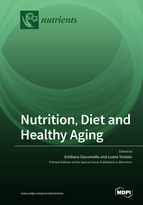Nutrition, Diet and Healthy Aging
A special issue of Nutrients (ISSN 2072-6643). This special issue belongs to the section "Nutrition and Public Health".
Deadline for manuscript submissions: closed (22 September 2021) | Viewed by 91907
Special Issue Editors
Interests: skeletal muscle; aging; metabolism; intracellular traffic
Special Issues, Collections and Topics in MDPI journals
Interests: striated mucle; nutrition; musculoskeletal system; muscle single fibres biophysics; muscle physiopathology; muscle aging and sarcopenia
Special Issues, Collections and Topics in MDPI journals
Special Issue Information
Dear Colleagues,
Over the last 100 years, the numerous advances in science, the improved sanitary conditions and a decline in poverty have led to an increase in life expectancy. As a result, in the coming years, the number of over-65s will triple, and the over-80s will be the fastest growing portion of the population.
However, an increased lifespan is associated with an increase in chronic diseases, such as cardiovascular disease, diabetes, cancer, sarcopenia, and degenerative disorders. Therefore, ideally, increased lifespan should be associated to a better healthspan, which is the period one individual is living in good health.
Based on evidence that aging is a multifaceted phenomenon, resulting from one or more failures at the molecular, cellular, physiologic, and functional levels, age-related diseases are difficult therapeutic targets.
Data on the correlation between the quality of one’s diet and life expectancy, and the application of calorie restriction regimens, or of micronutrients, antioxidants and functional foods in the diet make nutrition, together with exercise, a natural weapon to combat age-related diseases and improve healthspan.
The aim of this Special Issue is to update knowledge on the mechanisms responsible for aging and the nutritional strategies to overcome age-related diseases.
Dr. Emiliana Giacomello
Dr. Luana Toniolo
Guest Editors
Manuscript Submission Information
Manuscripts should be submitted online at www.mdpi.com by registering and logging in to this website. Once you are registered, click here to go to the submission form. Manuscripts can be submitted until the deadline. All submissions that pass pre-check are peer-reviewed. Accepted papers will be published continuously in the journal (as soon as accepted) and will be listed together on the special issue website. Research articles, review articles as well as short communications are invited. For planned papers, a title and short abstract (about 100 words) can be sent to the Editorial Office for announcement on this website.
Submitted manuscripts should not have been published previously, nor be under consideration for publication elsewhere (except conference proceedings papers). All manuscripts are thoroughly refereed through a single-blind peer-review process. A guide for authors and other relevant information for submission of manuscripts is available on the Instructions for Authors page. Nutrients is an international peer-reviewed open access semimonthly journal published by MDPI.
Please visit the Instructions for Authors page before submitting a manuscript. The Article Processing Charge (APC) for publication in this open access journal is 2900 CHF (Swiss Francs). Submitted papers should be well formatted and use good English. Authors may use MDPI's English editing service prior to publication or during author revisions.
Keywords
- Aging
- Lifespan
- Healthspan
- Diet
- Caloric Restriction
- Geroprotectors
- Functional Foods
- Antioxidants
- Exercise







